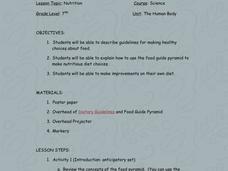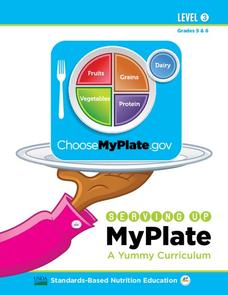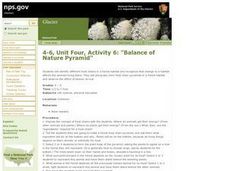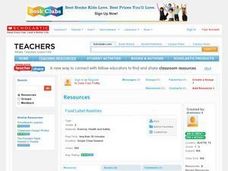Curated OER
Nutrition
Seventh graders describe the healthy choices about food. In this nutrition lesson, 7th graders use the food pyramid to help them in making nutritious choices. Students discuss their diet and talk about how it can be improved.
Curated OER
My New Food
Students create new fruits and vegetables and describe their health benefits. In this nutrition lesson, students work as a class to produce a new fruit or vegetable, make it using modeling clay, and describe the features. Students then...
Virginia Department of Education
Go with the Flow
How does nature's hierarchy relate to our local human environment? Answer this question, along with others, as the class visually depicts the natural hierarchy provided by nature. Pupils discuss each piece of the pyramid and its energy...
Curated OER
Energy Flow Through Ecosystems
Middle or high school environmental studies classes will learn much from this presentation on energy in ecosystems. It covers the foundational topics of trophic levels, food webs, and nutrient cycles using informational text and...
US Department of Agriculture
Serving Up My Plate
Within three nutrition-themed, inquiry-based learning opportunities, pupils take notice of their eating habits; delve deep into the five food groups, gain experience in planning meals, participate in a taste test, and explore ads from...
Cooking Matters
Cooking Matters: For Chefs and Kids
Get your scholars cooking with a collection of activities that pairs the class to a community chef, promotes healthy snacking and drinking, and explores fruits and vegetables. Lower elementary learners create vegetable super heroes,...
Choose My Plate
MyPlate Crossword Puzzle
Reinforce food group facts with a crossword puzzle that highlights healthy nutrition and cooking habits as presented by the MyPlate eating recommendations.
Choose My Plate
MyPlate Word Blanks
Create a silly cooking themed story using nouns, adjectives, verbs, and more! Pupils fill in the blanks using their knowledge of different types of fruit, vegetables, grains, protein, and dairy, then read the story aloud to hear a whacky...
Utah Education Network (UEN)
Balanced Diet
Second graders investigate the concept of a balanced diet and how the food pyramid is organized. They conduct research using the links included in the instructional activity. They differentiate the parts of the pyramid while looking at...
Curated OER
Food for Thought
Fifth graders explore the brain and what is needs. In this biology lesson plan, 5th graders will work on a series of activities that will allow them to learn about the brain, its parts, and the best foods to eat for their brain.
Curated OER
Food Math
Fourth graders explore healthy habits by completing caloric measurement activities. In this food choice lesson plan, 4th graders discuss what types of foods give you protein or fat and utilize a food chart to measure caloric intake....
Curated OER
Balance of Nature Pyramid
Students study the concept of food chains and create a physical forest food chain pyramid. In this balance of nature pyramid instructional activity, students identify the ingredients needed on each level of the pyramid then make...
Curated OER
Nutrition
Pupils design a meal plan with healthy foods based on the food guide pyramid. In this nutrition lesson plan, students identify healthy and unhealthy choices, watch a PowerPoint, and complete a group activity based on the food pyramid.
Curated OER
Predator-Prey Relationships
Learners explore the interrelatedness of predators and prey in four different activities. They simulate an aquatic insect, fish, and osprey food chain during a poker chip game, play an M&M game to simulate the relationship between...
Curated OER
Ecological Pyramids
Learners apply the ecological pyramids of numbers and biomass with an activity using topographic maps. In this trophic level activity, students work in groups using a topographic map to determine the number of organisms that can live in...
Curated OER
Food Label Realities
Second graders identify nutritional information on food labels. In this nutrition lesson, 2nd graders bring in food labels from home and practice reading them. Students discuss the nutritional content, such as caloric content. Students...
Curated OER
Reading Food Labels
Fourth graders examine the food labels on two similar items that are very different nutritionally such as a can of regular soda and a can of diet soda. Next they, sort through food labels to determine healthy and unhealthy foods by...
Curated OER
The Balance of Good Health and the Food Pyramid
Students explore the importance of good health and the food pyramid. They examine food labels and the importance of healthy food choices. Students investigate food additives.
Curated OER
Recommended Daily Food Intake Vs. Actual Intake
Students see how their daily food intake compares to the recommended daily intake. They will use computer skills, math skills, and develop or reinforce nutritional facts about eating healthy. After compiling their data, students discuss...
Curated OER
Eating Healthy
Students review healthy eating habits, and demonstrate reading comprehension skills, including reading strategies, inference, literal meaning, and critical analysis.
Curated OER
Food and Nutrition
Students participate in an after school program that promotes decision making, cooperation, choosing healthy foods, recognizing and naming a variety of foods, state healthy benefits from eating healthy foods and involving oneself in...
Curated OER
Family Life Cycle - Children's Lab
Students identify the changing nutritional needs across the life cycle. They create and prepare a variety of healthy foods for children that provide adequate nutrients for optimum growth and development. They identify guidelines in...
Curated OER
An Inside Look at Apples
First graders examine and identify parts of an apple. In this biology lesson, 1st graders cut an apple in half and locate all the parts, use the apple halves as stamps, and create a bar graph displaying which apple types the students...
Curated OER
Picky Pyramid
Learners learn the food pyramid and compare their meals with suggested guidelines. Students graph their lunches, discuss the results and how their choices affect their level of energy.

























